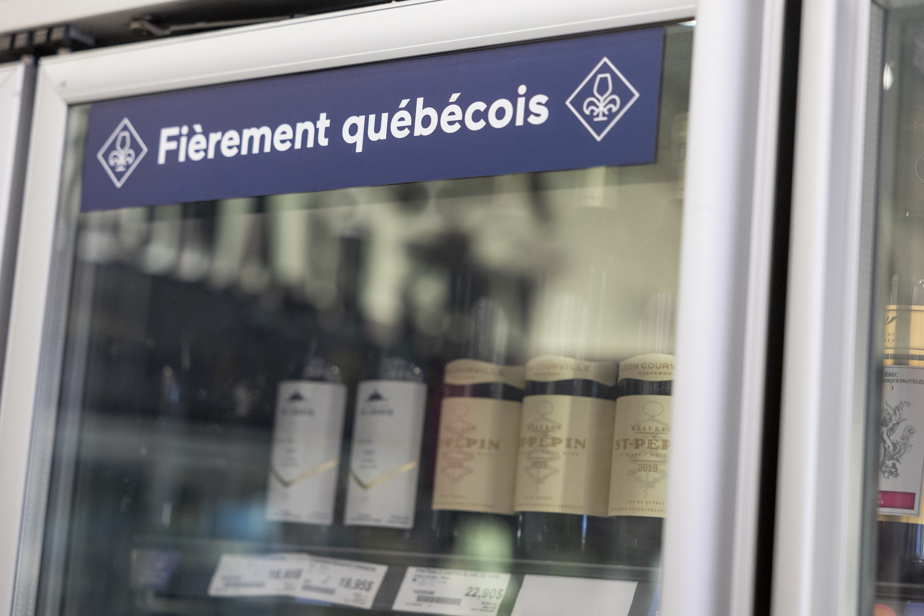Proof that local wines and spirits are more and more in the spotlight at cocktail hour or during meals, particularly at Christmas, sales of products identified as “Québec products” increased by 7, 1% at the SAQ in the third quarter of the 2022-2023 fiscal year, ending December 31, 2022. It remains to be seen whether winegrowers and distillers will succeed in stocking the shelves more, if demand is growing.
Thus, sales of products from Quebec reached $199.6 million compared to $186.3 million in the corresponding quarter of the previous fiscal year, according to the results published by the state corporation on Monday. These figures take into account the sales of 100% Quebec products, those that are bottled in the province and also those that are prepared in part with local ingredients. They represent 15.5% of sales. For their part, 100% Quebec wines and spirits – identified as Origine Québec – generated $12 million.
“Since COVID-19 and the madness for Quebec wines, it’s as if we had put oil in the machine”, illustrates Stéphane Lamarre, co-owner of the Château de cartes vineyard in Dunham. Without revealing figures, he assures us that the number of his bottles that find buyers at the SAQ is constantly increasing, adding in the process that the state-owned company is “his best business partner”.
Its vineyard produces an average of 100,000 bottles annually and nearly 60% go to the SAQ warehouses.
“Consumers’ enthusiasm for Quebec products and the strategies deployed by the SAQ to promote these products partly explain their performance for the third quarter,” said spokesperson Geneviève Cormier by email. Certain categories also stood out during this quarter, such as ready-to-drink (+23%), liqueurs (+9%), rums (+8%) and white wines from Quebec (+10%). ). »
The promotion of Quebec products is at the heart of the SAQ’s priorities and our local product offering will continue to gain momentum over the next year.
Geneviève Cormier, SAQ spokesperson
In the context, would Mr. Lamarre have the capacity to provide more? “It’s always been an issue,” he admits. “It’s clear that we’re running out of wine and that we’re going to run out of wine. But the answer is yes, I would be able to give a little more,” he adds.
However, the winegrower remains cautious and does not want to put all his eggs in one basket, to the detriment of his other markets: sales in grocery stores and directly at the vineyard.
Quebec wine lovers turn first to the SAQ when they want to buy their bottles, reveals a report recently published by the Conseil des vins du Québec (CVQ). Thus, in 2022, 32% of sales were recorded in the branches of the state-owned company, compared to 31% in the grocery store, 28% in the vineyard and 8% in the restaurant.
“I’m going to grow all the distribution channels at the same speed,” says Mr. Lamarre. He also reminds us that the desire to grow takes at least four years to materialize.
“My wish is to grow. But I have to prepare the land, plant seedlings before I get a bottle. »
At CVQ, President Louis Denault maintains that the number of bottles produced will increase over the next few years since a lot of vines have been planted. “We have reached three million bottles, and we may reach five million,” he calculates.
According to him, the state corporation must start preparing sooner rather than later. “For us, it’s important that the SAQ take all the steps to bring on board as many players as possible so that, when production increases, we are not instructing our winegrowers so that they know how to do it. their place in the SAQ. This is where it has to be. »
Overall sales increase
Moreover, as a whole, the SAQ seems to have had a particularly lucrative holiday season. In the third quarter, its sales reached 1.4 billion, against 1.35 billion for the corresponding quarter of the previous fiscal year, an increase of 5.4%.
After the madness of the pandemic, where many consumers who wanted to avoid going to the store too often bought larger quantities, the average shopping basket instead settled at $68.95, compared to $71.45 for the corresponding quarter of fiscal year 2021-2022.
Drop in online sales
Purchases made online, for their part, fell by 9.7%, from $83.9 million during the previous fiscal year to $75.8 million. They represent 3.1% of total sales.
“After significant growth during the pandemic, we are seeing a certain slowdown in online sales since our customers have resumed their buying habits from before and, therefore, have favored a return to an in-store experience,” explains Ms.me Cormier.
